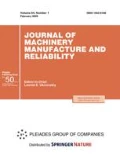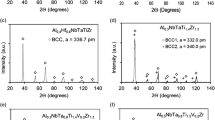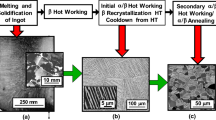Abstract
An accelerated method for determination of the stability of properties of alloys during their storage and subsequent application by studying the influence of the impact of radiation on the characteristics of shape-memory alloys is considered. The method allows for simulation of loading characteristics effective over the entire operating lifetime.
Similar content being viewed by others
Under modern conditions, nuclear power generation is becoming one of the leading branches of industry. In nuclear reactors, materials are subjected not only to mechanical loads, but also to intense radiation comprised of various ionizing particles.
The behavior of structural materials in nuclear energy facilities determines the optimal design, reliability, and lifetime of the latter. The basic criterion for selection of structural materials is their mechanical properties, since, under irradiation of the material by neutrons up to the integral dose γ = 2 × 1027 m–2, every atom of the lattice experiences more than 100 displacements. It is such integral fluxes that should be expected during the entire lifetime of thermal neutron reactors. Therefore, one of the most significant tasks is correct application of the existing structural materials and the development of new ones.
Any elementary particles the interaction of which with the substance results in formation of electric charges of different signs are ionizing particles. The ionizing particles are directly or indirectly ionizing particles. The former particles include electrons, alpha- and gamma-particles, and protons, i.e., particles that possess kinetic energy sufficient to ionize atoms under direct collision. The latter particles include neutron, photons, etc., that cause ionization by secondary effects. The physical parameters that characterize the basic properties of the ionizing radiation from the point of view of its influence on the materials are the charge, rest mass, velocity, and kinetic energy.
Radiation defects that result from ionizing radiation include point defects comprised of vacancies and an interstitial atom, clusters of point defects, dislocation loops, and micropores. Ionizing radiation causes changes in the mechanical properties of the materials, such as hardness, ultimate strength, yield strength, impact viscosity, impact toughness, plasticity, etc., associated with changes in the interplanar spacings in the crystal lattice, and formation of radiation-induced porosity. Radiation-induced porosity is accompanied by swelling of the material. Pores develop due to decay of the supersaturated vacancy solution in the metal.
The thermophysical properties of the metals are associated with thermal oscillations of the ions of the lattice, which depends on the structure of crystals and their electron characteristics. Under irradiation, not only does the structure of the metal change but so do also its thermophysical properties, i.e., heat capacity, heat and electric conductivity, etc. [1].
Electron bombardment of a substance results in the formation of comparatively simple defects towards the lowest stability.
Consequently, by creating defects in the crystal structure and intensifying the diffusion processes, we can simulate the condition a material will acquire over time in the distant future.
Changes in the properties of the material over time occur according to the diffusion mechanism, the process of which can be described by the equation
where D0 is the diffusion factor, K is the Boltzmann constant, T is the temperature, and E is the diffusion activation energy.
Relation (1) is met within a wide temperature range and holds true for both the initial and irradiated material [2].
Alloys that possess the shape-memory effect, i.e., materials that exhibit under definite conditions a capability to recover their initially acquired shape, have found many applications in various industries. These alloys are classified as intermetallic shape-memory alloys (SMAs).
The pattern of the development of thermoelastic martensitic transformations (MTs) is determined by specific manifestation of the strain memory termed “martensitic inelasticity” [3]. These transformations are determined simultaneously by structural phase transitions and geometrically reversible deformation processes. They occur both under changing temperatures within the direct and indirect martensitic transformation ranges and under mechanical impacts at temperatures below Md—the maximum temperature at which a martensitic transformation can be initiated by a mechanical impact. As Md > Ms, where Ts is the temperature of the beginning of the martensitic transformation, the patterns of the formation of martensite under free cooling and under load differ significantly [1].
It is rather difficult to analyze the deformation behavior of the alloys in the vicinity of the martensitic transformation with a simultaneous change in the stress σ and the temperature T. The dependences of the extent of the deformation on the working stresses σ at a fixed temperature T are presented in [4].
The application of SMAs in real structures, in contrast to structural materials, raises many questions about the following:
(i) the stability of thermal martensite deformed within the range of the martensitic inelasticity depending on the hold-up time and conditions prior to the austenitic transformation;
(ii) the completeness of the free shape recovery of the material deformed within the range of the martensitic inelasticity and the stability of the material over time depending on the operating conditions;
(iii) the magnitude of the stresses generated in the material during the recovery under the action of a counterforce depending on the degree of under-recovery of the deformed material and its stability depending on the operating conditions;
(iv) the conditions and extent of the manifestation of the superelastic state and the working stresses that occur in the course of the rhombohedral phase transformation (R-transformation) and the stability of the above characteristics depending on the operating conditions;
and
(v) the stability of the thermomechanical characteristics depending on the within-the-MT-range cyclic and radiation impacts [5].
METHODS FOR STUDYING THE CHARACTERISTICS OF SHAPE-MEMORY AND SUPERELASTIC MATERIALS
Study of the above characteristics of TiNi-based shape-memory materials depending on the time (within 15 years) and conditions of the external impacts involves certain difficulties. Tests under radiation impacts applied to structural materials allow for the ongoing processes to be controlled in the accelerated mode.
The accelerated tests by irradiation allow the simulation of loading characteristics that act over the entire operating life. One such method is radiation treatment based on the use of nuclear radiation, viz., neutrons, γ-quanta, α-particles, protons, electrons, etc.
Nuclear and thermonuclear reactors, artificial and natural isotopes, and elementary particle accelerators serve as sources of artificial radiation. These sources are a convenient tool for studying radiation damage in metals.
Linear electron accelerators (linacs) are widely used for studying radiation effects in the physics of radiation damage in metals. The practical use of linacs is determined by the flexibility of the control and safety systems. Using a linac, secondary particles of a wide range such as positrons, photons, and monochromatic and polarized neutron beams can be produced [6].
The most efficient action is high-energy electron beam irradiation. Metal materials irradiated by electrons are not activated and can be used without taking special radiation protection measures.
The uniqueness of the SMAs is not only that they exhibit the shape-memory effect but also that they acquire superelastic properties under the corresponding thermomechanical processing with the superelastic state reaching up to 10%. This phenomenon is associated with a special rhombohedral transformation (R-transformation). It can be manifested in both a narrow temperature range and, under processing in an appropriate way, can be extended to temperatures exceeding the inverse martensitic transformation range by 200°C. Consequently, we can obtain structures of materials that exhibit superelasticity within the operating temperature range [4].
According to findings on the electron structure and structural instability of TiNi [1], the R-phase is preceded by the electron transition accompanied by changes in the localization of electrons and the topology of the Fermi surface. The Fermi level in TiNi is located in the vicinity of the sharp density of states. Therefore, even a slight change in the concentration of electrons or their energy redistribution leads to changes in the concentration of Ni atoms in the matrix and transformation temperatures.
As applied to structures exposed to radiation impacts, it is necessary to consider how the radiation affects the physical and thermomechanical properties of the material.
Under irradiation, quite a few radiation defects, predominantly vacancies and interstitial atoms, arise in the material. The magnitude and character of dislocations in the crystal lattice are determined by the electron structure of the alloy. A significant feature of the electron structure of TiNi is the saturation of bound states of the d-band and a low state density at the Fermi level. The stability of the crystal lattice decreases in this case, and, as a consequence, the stacking fault energy is reduced. This effect results in the occurrence of an additional deformation mechanism, twinning. Twinning is an effective mechanism of stress relaxation in dislocation clusters that determines high plasticity. In the intermetallic compounds to which the TiNi alloy belongs, loss of stability leads to martensitic and R transformations at high plasticity at the same time. An increased defect concentration accelerates the diffusion processes at low temperatures.
Preliminary regularities of changes in the properties of a material depending on the time factor were determined, and the results on the effect of the irradiation by electrons with intensities from 2.5 × 102 to 105 rad were compared using samples to investigate the shape recovery (the TN1 alloy) and stressed state (the TN1-K alloy). The chemical composition of the alloys under test is presented in Table 1; in Table 2, the martensitic transformation temperatures are provided.
Qualitative studies were conducted using materials that were in the martensitic (TN1) and austenitic (TN1-K) states at room temperature.
The stability of the properties of thermal martensite deformed within the range of inelasticity of martensite was controlled for the components that recovered their initial shape after being stored in the deformed state for a long time. Plates of TN1 sheets with the thickness δ = 1 mm bent in a device at an angle of 90° and subjected subsequently to heat fixing to impart the required shape memory were used as samples. The bend radius was determined by the condition
where ε is the deformation ratio and δ is the thickness of the plate at the deformation ratio ε = 6%, i.e., the deformation on the outer surface of the plates did not exceed 8%.
In Fig. 1, samples are shown that, after being deformed to the rectilinear state, were stored in the martensitic phase under all-climatic conditions for 0.5 to 12 months. Some of the samples were irradiated at different degrees of exposure.
When the deformed martensite recovers, phase transformations occur according to the “J” scheme (Fig. 2).
The stability of the elastic-stressed state depends not only on which scheme of martensitic transformations occurs but also on the ratio of the yield strength of the material to the magnitude of the martensitic displacement. If the process occurs according to the “J” scheme, the martensitic phase is partially transformed into stress-induced martensite and austenite. Stress-induced martensite is metastable and exhibits superelasticity in the region close to Af. The instant of stress relaxation is shown by the dashed line in Fig. 3.
The studies of the behavior of superelastic alloys for the hold-up time (scheme J) of the loaded material (point A) for 120 hours show that the stresses relax. The recovery of the residual deformation resulting from the relaxation is possible only upon additional heating (section C–B).
The relaxation phenomena that occur in deformed martensite during a long-time hold-up are associated not only with the reduced mobility of the interphase boundaries but also with a partial plastic displacement of the material (section D–0).
Experimental results on changes in the temperatures As of the inverse martensitic transformation and the completeness of shape recovery f are shown in Fig. 3
Based on the results of the tests conducted after 3, 6, 9, and 12 months of storage of deformed martensite at temperatures below Мf, it was established that no considerable changes in either the degree of shape recovery f or the temperature of the beginning of inverse martensite transformation As were observed. Changes in the resistivity over the entire observation period were within the range of measurement error. Consequently, the long-time storage of deformed martensite did not cause any structural changes.
The patterns of change in the properties of deformed martensite studied experimentally depending on the intensity of irradiation are shown in Fig. 4.
The results of studies show that the temperatures of the beginning and end of the martensitic transformation increase and depend significantly on the exposure dose. However, under irradiation at an exposure dose of up to 104 rad, the completeness of shape recovery under heating to the temperatures Af changes insignificantly [7].
Considerable changes in the thermomechanical properties of the material start under irradiation at the exposure dose γ > 106 rad.
For alloys with an increased content of Ni and Fe-doped alloys, the martensitic transformations are accompanied by the formation of the R-phase.
If the elastic-stressed state is achieved according to the G-scheme (Fig. 6), the superelasticity state may develop up to the Мd temperatures that lie within the operating temperature range. Figure 5 shows a diagram of the characteristics of the elastic-stressed state with the transformation. In this case, the superelastic state persists and the plastic deformation is suppressed to such a degree that even a long-time hold-up under a constant load for 120 hours does not lead to significant changes.
Studies on the duration of holding the material in the elastic-stressed state were conducted using samples of the TN1-K and TN1-K* alloys. The stressed state of the material was achieved by stresses generated during the transformation of the martensite from inelasticity into the austenitic phase under heating and size recovery.
Smooth ring bushings set onto polished rods (Fig. 6) were used as samples.
The deformation of the bushings within 8% occurred in the martensitic state at the temperature of liquid nitrogen. When heated to normal temperatures, the bushings were compressed with the residual under-recovery deformation being 3.2–3.5%. Upon heating, breakaway forces were determined at a displacement velocity of 10–12 mm/min.
To determine the time dependence of the stress relaxation, a number of the samples were stored under normal conditions for a preset period of time. The other part of the samples, prior to storage, was exposed to γ-radiation on a facility with a Co60-source at a distance of 1 mm from the object under irradiation. The exposure dose was 10–3 rad/h at a dose rate of 1 MCi. The irradiation was conducted in a vacuum of 10–3 mm Hg with the dose accumulated by the samples being 3 × 109 rad.
After the preset storage time had elapsed, the breakaway forces were determined. Comparative analysis of the displacement forces of the smooth bushings made of the TN1-K and TN1-K* alloys depending on the storage time and the radiation impact is shown in Fig. 7.
CONCLUSIONS
Based on the results of this study, we should note that for the TN1-K alloy samples the displacement forces drastically decreased after a hold-up time of up to 24 hours. The bushings removed from the rods showed residual (plastic) deformation within 1.5–2%. Long-time storage probably facilitates the straightening of the elastic-stressed state of different sections of the bushing increasing the actual contact area. The exposure to radiation probably accelerates the processes.
The dependence of the characteristics of the material on the storage time upon deformation in the martensitic state and the rate of γ-quantum radiation was studied using samples of the TN1 and TN1-K alloys.
For the bushings of the TN1-K* alloy (Fig. 6), which exhibit the R-transition and the property of superelasticity, the displacement forces do not depend on the duration of the elastic-stressed state while the exposure to radiation causes an increase in the thermomechanical characteristics. The check tests of the bushings for the residual deformation showed that it was within the range 0.5–0.8%.
Comprehensive investigation of the electron structure of TiNi, by positron annihilation, magnetic susceptibility, and X-ray electron and optical spectra, shows that the rhombohedral R-phase is preceded by the electron transition with a change in the localization of electrons, which results in a change in the Fermi surface topology. Therefore, even a slight change in the concentration of electrons and their energy redistribution may lead to a noticeable change in the stability of the β-phase of TiNi with respect to the shift and formation of the R-phase.
Irradiation with high-energy electrons at a dose of up to 3 × 109 rad not only stabilizes the working stresses but also does not affect the manifestation of the SME.
Given the aforementioned, X-ray and neutron diffraction studies of alloys that exhibit the superelasticity effect depending on their operating conditions are of great interest.
The constancy of the properties of materials that exhibit the shape-memory effect, superelasticity, plasticity of transformations, etc., is of great significance when such materials are in use; therefore, such alloys should be subjected to treatment that results in stabilization of the above properties.
REFERENCES
Khasyanov, U.I., Romanov, A.N., Khasyanova, D.U., and Khrushchov, M.M., Self-oscillation conditions in alloys with the shape memory effect, J. Mach. Manuf. Reliab., 2018, vol. 47, no. 3, p. 278. https://doi.org/10.3103/S1052618818030081
Kurdyumo, G.V., Story of the establishment of the orientation relations between the lattices of martensite and austenite, Phys. Met. Metallogr., 1986, vol. 61, no. 4, p. 1.
Shape Memory Alloys, Funakubo, H., Ed., London: Taylor Francis, 1987.
Khas'yanova, D.U., Conditions for operational reliability and tightness of thermomechanical joining pipelines using couplers, J. Mach. Manuf. Reliab., 2020, vol. 49, no. 2, pp. 110–115.
Ursanu Dragoş, A., Stanciu, S., Cimpoesu, R., Paraschiv, P., and Bernevig, M., NiTi shape memory alloy active element behavior in long time solicitation conditions, Appl. Mech. Mater., 2014, vol. 657, p. 387.
Alimov, A.S., Ishkhanov, B.S., and Shvedunov, V.I., Compact linear electron accelerator for radiation technologies, Moscow Univ. Phys. Bull., 2008, vol. 63, no. 4, pp. 256–258.
Effekty pamyati formy i sverkhuprugost' (Shape Memory Effects and Superelasticity), Kiev: Inst. Metallofiz., 1980.
Author information
Authors and Affiliations
Corresponding author
Additional information
Translated by O. Lotova
About this article
Cite this article
Khasyanova, D.U. The Use of Accelerated Test Method for Alloy with Shape Memory Effect and Superelasticity. J. Mach. Manuf. Reliab. 49, 705–711 (2020). https://doi.org/10.3103/S1052618820080038
Received:
Accepted:
Published:
Issue Date:
DOI: https://doi.org/10.3103/S1052618820080038











